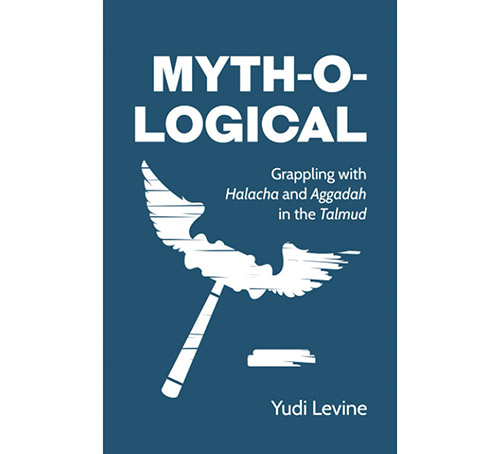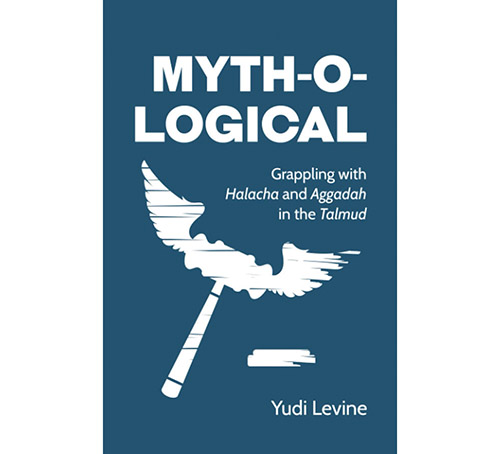
Reviewing: “Myth-O-Logical: Grappling with Halacha and Aggadah in the Talmud,” by Yudi Levine. Shikey Press. 2022. English. Paperback. 187 pages. ISBN 13: 978-1958542149.
It is rare to come across a seemingly entirely new genre of Torah literature but I believe I have experienced this with “Mytho-O-Logical: Grappling with Halacha and Aggadah in the Talmud” by Yudi Levine. This very substantive work deals with the relationship between Halacha and Aggadah, and points out that they are not two separate, isolated disciplines; rather, they relate to each other and interact.
While that could be what makes this book unique, what really puts this publication into its own category is the author’s taking to the nth degree of the Rambam’s principle of accepting the truth from anyone, which gains its source from Pirkei Avot.
In fact, he goes one step further, as he points out, “While some of these topics may not be strictly Aggadic, the idea behind discussing these topics is the same. They are all elements of truth, and truth can sometimes be discovered through Eminem Lyrics.” (Page 8). There is no need to worry, as the author clarifies in a footnote, “And when I say sometimes, I mean almost always.” As such, the reader should not be surprised to learn about Eminem, “The Little Engine that Could,” the store Big Lots, “The Big Lebowski,” and Tupac, to name a few examples. While many other authors make reference to people and/or events found in pop culture, Levine actually includes detailed accounts about all of these items and utilizes them in developing and teaching ideas.
While using his humor in a very postmodern and self-referential manner, the author provides a very comprehensive discussion about the worlds of Halacha and Aggadah. He shares with us who can learn Aggadah and what prerequisites are necessary to gain value from the material. He warns the reader to approach Aggadah from the proper perspective because, “If read the wrong way, the wrong conclusions will be reached. Objectively false ones.” (Page 17)
The author mentions the appeal of Aggadah, which makes its messages impactful and memorable. In utilizing an example of an ad showing the dastardly effects of drunk driving, the author relates that, “The Talmud is full of halacha and Aggadah. If you are OK with Pandora running ads against drunk driving by using the story of Brian to tell the tale, you can’t really question the Talmud for including both law and storytelling.” (Page 12). He points out that Aggadah makes the issue approachable and knowable to all when placed properly within a good narrative. So much so, the author finishes the book by saying that, “When it comes to Halacha and Aggadah, the richer my understanding of one will almost always result in a richer understanding of the other.” (Page 184).
Levine also proves how midrash impacts Halacha. “This is the power of good storytelling. You can make a Supreme Court ruling on a First Amendment issue approachable and knowable to all when placed properly within a good narrative. It can even impact the law itself, by acting as proof for what is normative.” (Page 15). This book, in fact, mimics the Aggadic approach by presenting substantive material in an entertaining story-like fashion. It is so engaging that the reader may not realize how much breadth and depth they have just devoured in such an easy read. He shares themes found across Shas, including in-depth discussions about choosing between learning, and the relationship between kabbalah and Halacha. Finally, very apropos for this time of year, Levine tackles the very large issue found at the beginning of Mesechet Pesachim.
The Gemara spends a lot of ink on determining what the Mishna means when discussing why we search for chametz in our houses on the “ohr” of the 14th of Nisan. While “ohr” is often translated as light or day, we know that we check our houses at night. The Mishna, however, could have saved the Gemara a lot of time by just saying it is the night of the fourteenth. The author highlights for us a very powerful insight for the need to utilize “ohr” as opposed to night, while explaining the entire need to search for chametz in general.
The author points out that Gemara also has a very comprehensive Halachic discussion about the laws of what creates a marriage, what wording and actions are required, and when there is a doubt at hand. Quite interestingly, “What we have here is a nuanced and detailed halachic discussion, amongst many some of the foremost halachic authorities, that ultimately is predicated on the story of Hashem taking the rib from Adam during his sleep and creating a woman.”
Levine shares what value the role of midrash plays. “But that which is fantastical can inform us. We can learn what we want, through fiction and illusion,through art, through the truths taught to us in stories.” (Page 49).
I leave you to enjoy this book and begin to understand many perplexing midrashim in an engaging and enjoyable way as you flip through the many fundamental insights to be gleaned concerning the role and function midrash plays in our Torah framework. I, however, will be moving on to my next Yudi Levine book.
Rabbi Eliezer Barany is an editor and serves as a high school rebbe at Posnack Jewish Day School in south Florida.










